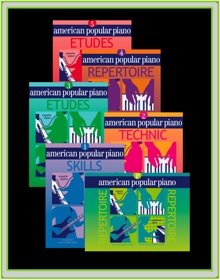Summer Sizzle is a summer music camp for piano teachers and piano students, held in a lovely small town in southern Ontario, Palmerston. It was the 9th year for Summer Sizzle this year and the biggest attendance yet. There were lectures and seminars for teachers, master classes and one-on-one sessions for students, improvisation workshops and a Keyboard Kamp (spelling deliberate!) for the children, run by a number of very able and enthusiastic musicians. Here are some of the students who took part in Summer Sizzle in 2009:

I was asked to run a series of improvisation sessions, using American Popular Piano Preparatory Etudes right through to Level 7 Etudes. My first session was for absolutely all participants and it was great fun – I got lots of students to come and try improv ideas out, with me and with tracks and I also got the whole group to do things. It set the tone for subsequent sessions, which were for smaller groups of students. Here’s one of my students, jamming away and concentrating hard!

I started the improv sessions with individual students but finally worked my way to having 8 students on 4 keyboards, all taking turns to solo but often keeping chords or riffs going under the other soloists.

Yup, that’s me in shorts..
Scott McBride Smith meanwhile was supervising master classes – students were asked to prepare pieces by er, me and he imparted his amazing teaching wisdom both to the players and to the onlookers. Here he is with a student:

The best 15 students were chosen (by Scott) to play in a Christopher Norton concert on the Monday night and I felt that Scott’s work plus the improvisation sessions meant that something really special happened. The students played with confidence and verve (including some jamming on stage) and the audience was positively electrified by the atmosphere of the event.

As you can see, I jammed along with the students some of the time in the concert, which was unrehearsed but worked wonderfully well most of the time.
I also did a seminar on vertical harmony (the analysis of chords divorced from functional harmony) and I think most teachers found this interesting! My aim was to get teachers enthused about individual chords (and recognizing them as well) all over again.
This was a really special music camp and I hope I might get back there next year. Hopefully we will see some readers there too!




 We used a grand piano as well as a keyboard, usually with 4 students in a group. I get all of the students to play the piece together first, with two students playing the original left hand part, the other two playing the original right hand part. We then try out drum patterns that might sound right for the piece, often derived from the teacher accompaniment. The students them "drum" while one of the group plays the piece. With a tapped beat from their foot as well, it's really getting the student used to keeping a beat as well as hearing other rhythmic parts while playing their part.
We used a grand piano as well as a keyboard, usually with 4 students in a group. I get all of the students to play the piece together first, with two students playing the original left hand part, the other two playing the original right hand part. We then try out drum patterns that might sound right for the piece, often derived from the teacher accompaniment. The students them "drum" while one of the group plays the piece. With a tapped beat from their foot as well, it's really getting the student used to keeping a beat as well as hearing other rhythmic parts while playing their part.










